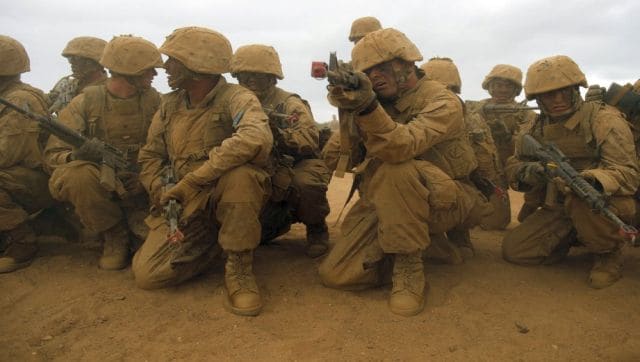US Marines: A ‘few good men’ who pay the heavy price of keeping the US flag flying
[ad_1]
These special troops have been a part of every war – from Vietnam to Afghanistan – that America has ever fought
Thirteen United States military troops were killed in the bombing attack on Kabul airport on Thursday amounting to the worst single-day loss for the Pentagon in Afghanistan since 2011.
The 13 US Marine Corps soldiers died when two bombers deployed by the Islamic State group detonated their bombs by a key gate near the airport where the troops are overseeing evacuations.
As America mourns their losses, just who are these soldiers, termed as “heroes” by President Biden, and what role do they serve in the military.
The American service members who gave their lives were heroes. Heroes who have been engaged in a dangerous, selfless mission to save the lives of others. We have a continuing obligation — a sacred obligation — to their families that will last forever.
— President Biden (@POTUS) August 26, 2021
Who are the US Marines
The United States Marine Corps, also referred to as the United States Marines, is a separate military service within the US Department of the Navy.
It was established on 10 November 1775, to augment the naval forces in the Revolutionary War.
After many successes, the Corps was abolished at the close of the Revolutionary War, citing economic reasons. It was then set up once again on 11 July, 1978.
The US Marines are responsible for conducting expeditionary and amphibious operations through combined arms, implementing its own infantry, armour, artillery, aerial and special operations forces.
Marines have participated in all wars of the United States, being in most instances first, or among the first, to fight. In addition, Marines have executed more than 300 landings on foreign shores and served in every major US naval action since 1775.
Marines and the Vietnam War
The US Marines played a significant role in the Vietnam war. They provided ground, air, supply, and logistic support in the Vietnam War for over two decades as part of III Marine Amphibious Force.
The intermittent war against the North Vietnamese Army and the guerilla war against the Viet Cong earned the Marine Corps a frightening reputation.
Vietnam was the longest war up to that time for the Marines; by its end, an approximate 13,000 had been killed in action, over 51,300 had been wounded, and 57 Medals of Honor had been awarded.
1980s and the Marines
The 1980s brought an increasing number of terrorist attacks on US embassies around the world. Marine Security Guards, under the direction of the State Department, continued to serve with distinction in the face of this challenge. In August 1982, Marine units landed at Beirut, Lebanon, as part of the multi-national peace-keeping force. For the next 19 months these units faced the hazards of their mission with courage and professionalism.
On 23 October 1983, the Marine barracks in Beirut was bombed, causing the highest peacetime losses to the Corps in its history (220 Marines and 21 other service members were killed) and leading to the American withdrawal from Lebanon.
The Gulf War
In August 1990, the Iraqi invasion of Kuwait set in motion events that would lead to the largest movement of Marine Corps forces since World War II. Between August 1990 and January 1991, some 24 infantry battalions, 40 squadrons, and more than 92,000 Marines deployed to the Persian Gulf as part of Operation Desert Shield. Operation Desert Storm was launched 16 January 1991, the day the air campaign began.
The main attack came overland beginning 24 February when the 1st and 2d Marine Divisions breached the Iraqi defense lines and stormed into occupied Kuwait. By the morning of 28 February, 100 hours after the ground war began, almost the entire Iraqi Army in the Kuwaiti theater of operations had been rendered ineffective, resulting in a victory for the US.
The Afghanistan Campaign
As part of the United States’ ‘Global War on Terror’, the US Marines were deployed in Afghanistan to fight the Taliban and the Al Qaeda. US Marines invaded in October 2001 to oust the Taliban, who they said were harbouring Osama bin Laden and other Al Qaeda figures linked to 9/11.
As per estimates, the Afghanistan war has seen more than 2,300 US Marine soldiers being killed and an additional almost 21,000 being injured.
As years passed in Afghanistan, troop deployment kept reducing and in January 2021, there were 2,500 personnel – the lowest since 2001.
In April, top US national security officials discussed their plan for final withdrawal of troops from Afghanistan.
On 14 April 2021, President Biden announced his intention to withdraw all regular US troops by 11 September 2021, the 20th anniversary of the 11 September attacks and four months after the initially planned 1 May deadline.
Things turned sour when the Taliban seized the capital on 15 August and the Afghan government dissolved, surprising the US government and the world alike.
The US Marines have been put in charge of the evacuations from Afghanistan, and as of 23 August, they had helped to get approximately 48,000 people out of Afghanistan and they are racing against time to get as many out before the deadline of 31 August.
Peace missions
The Marines have also extended a helping hand in humanitarian efforts.
They have been called in to contain wildfires, and have also supported hurricane relief efforts in various parts of the country.
In December 2004, when the tsunami struck numerous nations in the Indian Ocean region killing more than 150,000, Marine units were immediately deployed to Thailand, Indonesia, and Sri Lanka to assist in disaster relief operations.
Inputs from agencies
[ad_2]
Source link


Comments are closed.